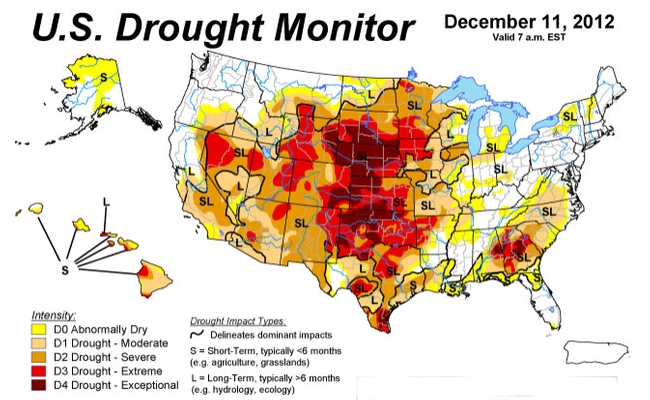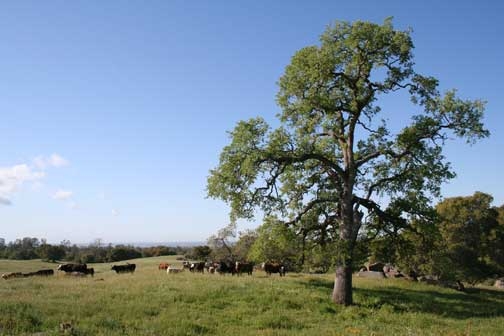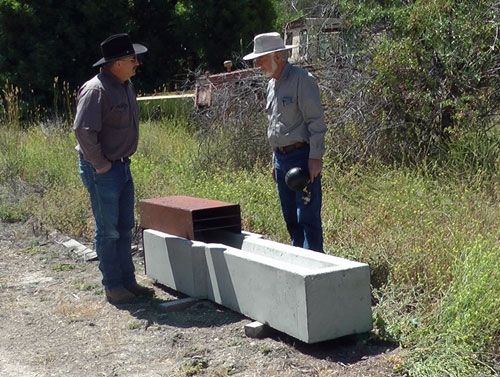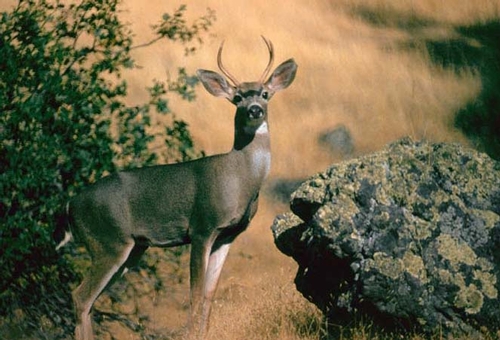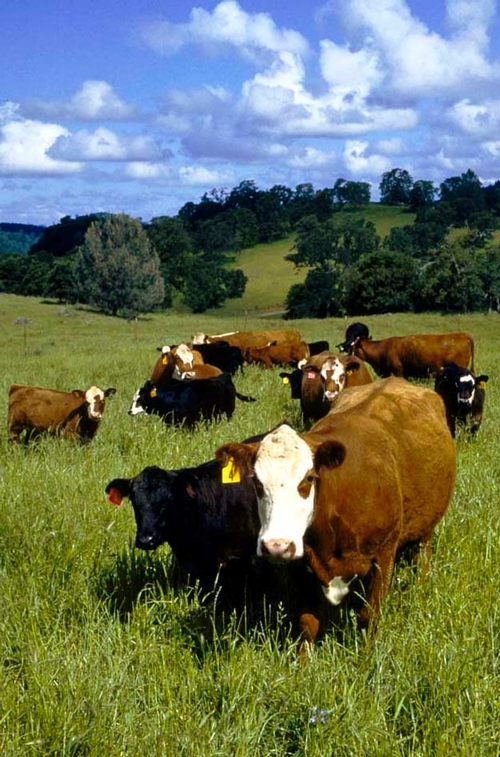Posts Tagged: rangeland
Ranchers view UCCE test plots during spring range tour
UC Cooperative Extension range research was featured at a field day Saturday in Tehama County, reported Julie Johnson in the Corning Observer.
Josh Davy, UCCE advisor in Tehama County, reviewed test plots were 60 varieties of annual and perennial range grasses were growing. Ken Tate, UCCE specialist, and Leslie Roche, postdoctoral researcher, both in the Department of Plant Sciences at UC Davis, gave an update on their long-term grazing research projects evaluating the effects of multiple grazing treatments. Guy Kyser, UCCE specialist in the Department of Plant Sciences at UC Davis, talked about weeds.
Tony Turri, owner of the ranch that hosted the field day, said he has worked extensively with the UC Cooperative Extension.
"There are a lot of factors and organizations that are trying to harm the cattle industry," he said. "Events such as this are important in our ability to stay in cooperation with each other and provided education and information to keep us in business."
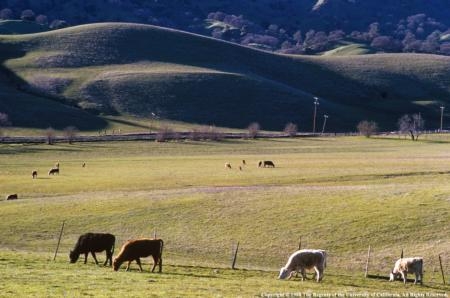
Medusahead, barb goatgrass and yellow starthistle were some of the weeds researchers discussed at the field day.
Rain has painted California rangeland green
Steady rain so far this fall has produced a verdant emerald green panorama on California rangeland, reported Capital Press this week.
Livestock producers are elated, said Josh Davy, a UC Cooperative Extension advisor in Tehama County.
"It's been nice to start the year with some big rains because it fills up the reservoirs, puts some drinking water out there and it helps build deeper soil moisture in case it doesn't rain later," Davy said. "We hope it keeps going until March."
The 2012 rainy autumn has helped much of Northern California emerge from drought conditions, according to the U.S. Drought Monitor. Parts of the southern San Joaquin Valley are still in severe drought, but conditions have shown some improvement.
UC Davis olive center to look at ways to reduce wastewater
Melanie Turner, Sacramento Business Journal
The UC Davis Olive Center and USDA-Agricultural Research Service have been awarded a grant to develop innovative ways to reduce the amount of wastewater produced by the olive oil industry. Among the technologies to be evaluated is a “vibrating membrane system” patented by New Logic Research of Emeryville. The company will be providing the system for testing at no cost.
California's fall weather is getting rangeland grasses growing
Germination occurred as a result of the season's first rains in October, but it didn't hold in some pastures because of the lull in precipitation, Davy said.
"This ought to get it up and going," Davy said of the rain that fell before Thanksgiving. "It usually takes between half and 1 inch in a week to get it sparked up and going, and we have definitely had that."
California farmers efficient, study finds
Tim Hearden, Capital Press
A Fresno State Center for Irrigation Technology research report says California farmers are more efficient in managing their water supplies than they're sometimes given credit for. As a result, large volumes of "new water" cannot be developed through agricultural water conservation.
The Fresno State irrigation experts' yearlong study aimed to update a 1982 University of California Cooperative Extension report, "Agricultural Water Conservation in California with Emphasis on the San Joaquin Valley." The new study says the 1982 report correctly framed the potential for agricultural water-use efficiency.
Building a better water trough
“Water is the driver of nature.” - Leonardo da Vinci
California’s vast dry rangelands are dotted with water troughs ideal for quenching cattle’s thirst. But in most cases, the troughs’ designs are a torment to wildlife drawn for a drink.
Monterey County rancher George Work observed how traditional water troughs frustrated the wildlife on his family’s 12,000-acre cattle ranch. Small birds couldn’t reach water two or three inches below the top edge. Coyotes, bobcats and cottontails weren’t tall enough to reach over the rim. Work set to making a water trough that would meet the needs of all animals on the range – from cattle, hunting dogs and horses to deer and rabbits.
While raising cattle remains the primary function of the Work Ranch, in order to generate more income from the scenic open space the ranch opens its doors to hunting wild boar, quail and Tule elk. The visitors enjoy seeing a diversity of wildlife.
“One-third of our business comes from wildlife,” Work said.
In 1998, Work drew from decades of first-hand experience to design a better water trough. With a grant from USDA’s Natural Resources Conservation Service, he constructed a prototype. The concrete trough is sunk into the ground under an elderberry tree. Work modified a float like those used in toilet tanks to keep the water within centimeters of the rim.
That first man-made watering hole was an improvement for many species, but it also revealed some problems. Birds needed an escape ramp to climb out of the water should they fall in while drinking; the ramp should be shallow enough to allow the birds to bathe. Larger animals had to be kept from using the trough for a cooling dip. Work found that sloping the sides to a sharp V at the bottom of the trough made it unappealing for a soak.
Years of experimentation and innovation resulted in the development of pre-manufactured concrete water troughs, which are now commercially available. The next challenge is selling the idea to ranchers.
Enter UC Cooperative Extension. On an unrelated visit to the Work Ranch, UC Berkeley wildlife biologist Reg Barrett was impressed by Work’s invention and encouraged UC Cooperative Extension rangeland advisor Royce Larsen and NRCS rangeland conservationist Karl Striby to help spread the word.
Larsen and Stirby are now completing the first step, adding the ground-level water trough specifications to NRCS's published Technical Notes. The publication will provide ranchers and other land owners with the information they need to install the wildlife-friendly troughs.
“If you’re thinking of installing a basic, traditional trough for cattle, it may or may not be the best idea,” Larsen said. “But you’re thinking about supporting both cattle and wildlife, it’s great.”
In the video below, rancher George Work shows the ground-level water trough prototype and the second-generation, pre-manufactured version.
Groundlevel640
Loss of Williamson Act would threaten wildlife habitat
California’s premier farmland protection tool – the Williamson Act – is on the state’s budget-cutting chopping block and with it critical habitat needed for conservation.
A UC Davis study completed by a team of graduate students working with rangeland watershed specialist Ken Tate and other faculty found that 43 percent of the 10 million acres of “non-prime” land in the program, used primarily for cattle grazing, is also critical for statewide conservation goals. Conservation status was determined by the California Rangeland Conservation Coalition, a voluntary partnership between ranchers, environmentalists, government agencies, and others working to preserve and enhance the state’s rangeland areas.
For nearly 50 years the Williamson Act has provided private landowners with tax breaks in exchange for an agreement to keep land in agricultural or open space use for a specified period of time. The state compensated counties for the reduced property tax revenue but cut these subsidies in 2008 and again in 2009. Legislation passed in October (Assembly Bill 2530) allows counties to voluntarily implement modified contracts for reduced terms but does not ensure continuation of the Williamson Act beyond 2015.
To understand how loss of the Williamson Act would affect ranchers and the environment, the researchers surveyed 700 members of the California Cattlemen’s Association in 2010. Their findings confirmed what many in the industry already know: ranching is a low-profit industry. Seventy percent of surveyed ranchers made less than $10,000 in 2009 and less than half reported making a profit. Seventy-two percent of the ranchers surveyed consider the Williamson Act to be “extremely important” to their operations.
Survey results also show that loss of Williamson Act funding at the state level would put critical habitat at risk for development. Forty-two percent of the surveyed ranchers said they would sell some or all of their rangeland without the tax relief. Fifty-six percent of the ranchers predict their sold land would be developed for non-agricultural uses.
“California’s rangelands provide clean drinking water, wildlife habitat, open space, and sequester carbon among many other critical ecosystem services,” Tate says. “We need tools such as the Williamson Act to conserve this important landscape.”
Study authors include doctoral students Sarah Myhre, Iara Lacher, Will Wetzel, Dale Manning, and Dan Swezey. They were participating in a collaborative project for an “IGERT” traineeship focused on rapid environmental change. The program is funded by the National Science Foundation. A concise policy brief on the survey was published in October 2010 and includes an illustrated map of the areas that could be affected by the demise of the Williamson Act. The policy brief and additional information about the program is available online at http://reach.ucdavis.edu/programs/williamsonact.html.


